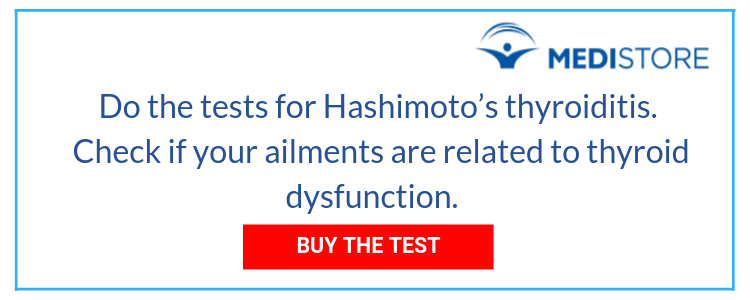Who gets Hashimoto’s thyroiditis?
Hashimoto’s disease mainly affects women. One in eight Polish women suffers from it. It is determined by both genetic and environmental factors. If undiagnosed, it can lead to hypothyroidism in young women, which can make it difficult to become pregnant and increase the risk of miscarriage.
For older women, it carries a risk of obesity and cardiovascular problems. If properly treated, the risk of complications can be avoided. This is why checking the thyroid gland is important.
Symptoms of Hashimoto’s thyroiditis
The symptoms of Hashimoto’s thyroiditis are not very characteristic. They often include:
- weakness,
- weight loss or weight gain
- decrease in immunity,
- skin changes,
- dry skin,
- swelling,
- menstrual disorders,
- constipation.
Hashimoto’s thyroiditis can also have other symptoms:
- constantly feeling cold,
- facial swelling,
- drowsiness,
- feeling constantly tired
- problems with concentration,
- nervousness, irritability,
- tachycardia (increased heart rate above 100 beats per minute),
- Hashimoto’s disease also causes infertility in women,
- men may experience decreased libido and erection problems.

Symptoms of Hashimoto's thyroiditis and hypothyroidism
For unknown reasons, Hashimoto's disease causes the immune system to "attack" its own cells. This leads to thyroiditis, which in turn can cause hypothyroidism.
The attack on the immune system and related inflammation destroy the thyroid parenchyma, causing it to produce fewer hormones: thyroxine - T4 and triiodothyronine - T3. This happens in about 25% of cases when Hashimoto’s thyroiditis is diagnosed.
Hashimoto’s thyroiditis is a chronic disease, and the changes it causes are, unfortunately, irreversible. The disease may lead to hypercholesterolemia with elevated LDL-cholesterol.
How is Hashimoto’s thyroiditis diagnosed?
In diagnosing Hashimoto’s thyroiditis, the first step is to check the thyroid gland by performing the TSH (thyroid-stimulating hormone) test. If the results are abnormal, the next step is to check the concentration of free thyroxine (FT4). If hypothyroidism is diagnosed, we must check for serum thyroid antibodies, in particular anti-thyroid peroxidase (anti-TPO).
Increased anti-TPO concentration is characteristic of Hashimoto's disease. Thus, the complete set of tests to diagnose Hashimoto's disease includes:
- TSH,
- fT4, ,
- TPO,
- ATG,
- Thyroid ultrasound.
Hashimoto’s thyroiditis and thyroid treatment
The best kind of treatment is one that targets the cause of the disease. Unfortunately, in the case of Hashimoto's disease, the cause is unknown. Treatment consists of eliminating the effects of too low hormone levels, and thus supplementing thyroid hormone deficiency.
Patients are given thyroxine - a natural hormone, an exact equivalent to that produced by a healthy thyroid. It is very important to choose the right dose, which changes as the disease progresses.
Treatment must be continued for the rest of the patient’s life. Upon diagnosis, patients should also change their eating habits, such as avoiding salt (as well as salt caves).
IMPORTANT: Patients with a family history of autoimmune thyroid disease should inform their doctors to avoid taking medication that may contribute to the development of the disease. They also need to regularly check their TSH levels to detect potential hypothyroidism as soon as possible and prevent its serious symptoms. |





